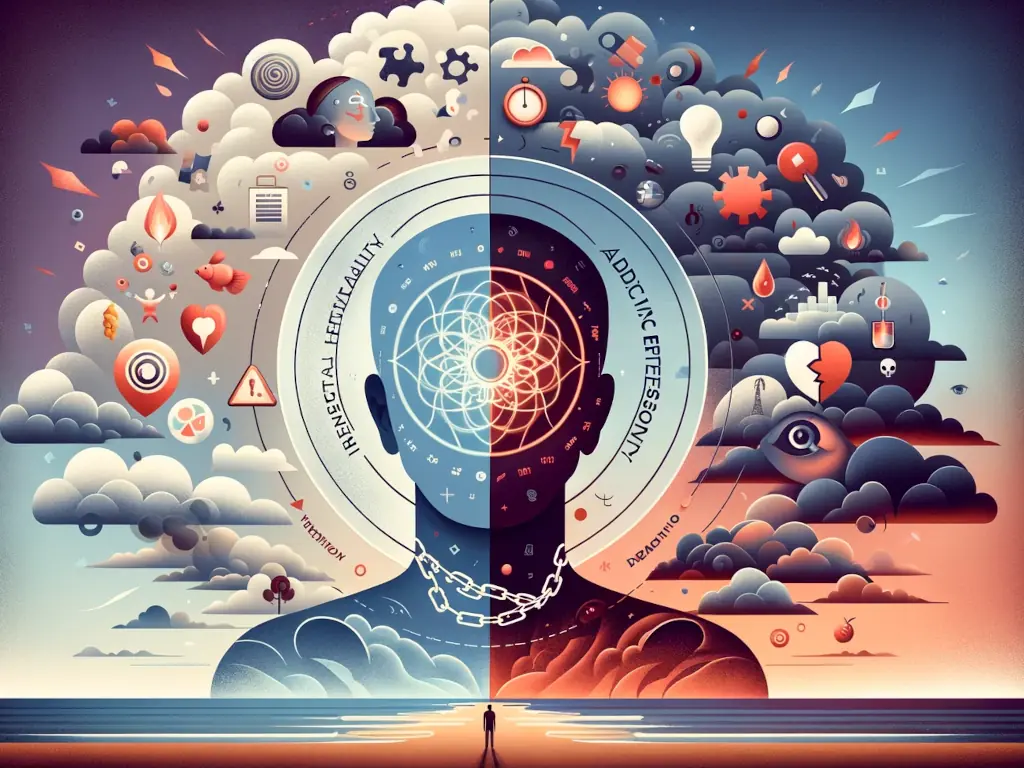How did this happen?
This is a question often asked by addicts and alcoholics as well as by concerned loved ones and friends. Following are excerpts from the book Addiction and Grace, by Gerald G. May M.D., and presents a sound explanation for the psychological and physiological roots of addiction.

Mind: The Psychological Nature of Addiction
Simply stated, if I do something that makes me feel good, I am likely to do it again. If I keep doing it, and if it keeps making me feel good, I will probably make a habit of it. Once I have made a habit of it, it becomes important to me and I will miss it if it is taken away.
In other words, I have become attached to it. The most important behavioral insight into addiction, then, is that attachment takes place through a process of learning. The learning need not take place on a conscious, intentional level; it is not a matter of consciously noticing the effects of a behavior and then deciding to make a habit of it. Instead, the process takes place automatically at a deep physical level.
In fact, most such learnings never do reach conscious awareness until they are already well entrenched, and may never come into awareness at all. Because habits and attachments are formed through this conditioning process are so deep and automatic, they can be extremely powerful and difficult to break.
How Attachment Happens:
We can understand the attachment process as occurring in three stages, which I call learning, habit formation, and struggle.
Stage One – Learning
The learning stage is characterized by associating a specific behavior with a feeling of pleasure or relief from pain. Let us say I engage in a behavior. It might be any behavior, intentional or unintentional, from taking a drug to counting my money, from biting my nails to thinking of God in a certain way. When I first perform this particular activity, I experience a feeling of pleasure or relief from distress.
My brain automatically associates these effects with the behavior. If the pleasurable effect is immediate and powerful, my brain will make a strong association between the behavior and its effect in this single experience, and already it will be pushing to repeat the behavior. If the feelings are weaker or less immediate, it may take many reenactments of the behavior for my brain to solidify the association and start to request repeat performances. Either way, each time the behavior occurs, the association is reinforced, making me more likely to repeat it. Thus, certain attachments can develop almost instantaneously, while others may take a long time. This form of learning is known as conditioning; it is the primary way we “learn” to be addicted, and it can happen altogether unconsciously.
Stage Two – Habit Formation
Up until now, the behavior and its effects have been associated only with each other. When the conditioned pattern becomes associated with other experiences in my life, I will become more active in repeating the behavior. Then a full-fledged habit develops. For example, I may be feeling a little depressed because of some disappointment in my life. My brain will make the association that if I “do” this particular behavior, I will feel better. Therefore I find myself wanting to perform the behavior as a way of dealing with the depression. Now I not only repeat the behavior for its own desired effect, but I also actively seek it as a reaction to stress or discomfort in other areas of life. This is the primary effect of Stage Two: increased frequency of the behavior.
The second stage involves actively seeking the effects of the behavior in a variety of life situations. Doing the behavior for its effects seems much more intentional than the automatic repetitions of Stage One, but it can still happen completely outside of consciousness. In most cases, I will be totally unaware that I am using the behavior in this way into Stage Three, when something prevents me from performing the behavior, or when it starts to cause problems.
Stage Three – Struggle
By now my associations have become so entrenched that the habit is an integral part of my life. Upon encountering any upset or distress, my desire to do the behavior surfaces like a reflex. And even in the absence of stress, I begin to feel uneasy if I go too long without repeating the behavior. Whether the behavior involves taking a chemical, losing myself in some pleasurable interpersonal experience, or holding a particular image of God, I am now becoming dependent upon it, needing it, and wanting more and more of it. This is the beginning of tolerance.
With this increasing need and frequency (tolerance), something is bound to interfere with my habit sooner or later. Such interferences may occur in any number of ways. If my behavior involves a drug, food, money, or some other substance, I may have trouble keeping myself supplied. If it involves another person, any change in the relationship will threaten my attachment. Or perhaps someone points out my growing dependency, or I become aware of it on my own and decide to quit or moderate it. In this last case, I myself become the source of the interference.
Regardless of how such interferences arise, the behavior that I have become accustomed to is blocked, and I react with distress. In other words, the habit has now become its own source of stress. In addition, the blocking of the behavior produces backlash feelings that are the opposite of those that first caused the nature of the behavior; this distress and pain may range from mild uneasiness to true agony. Either way, the circle of attachment is completed with withdrawal symptoms.
For several reasons, interferences actually reinforce rather than lighten my attachment. First, since I have now learned to deal with stress by repeating the behavior, the stress of having my behavior interfered with only makes me want to perform the behavior more. If I become my own source of interference by trying to quit, I learn firsthand about mixed motivations as my attempts to quit continually increase my desire to continue!
Second, behavioral psychologists have long known that intermittent gratification is a powerful means of conditioning. A habit is more strongly reinforced when the positive effects of the behavior occur intermittently than when they are constant. This is one reason gambling, fishing, hunting, and other behaviors that have intermittent and unpredictable payoffs are so addictive. It is also why attempts to moderate or cut down an addictive behavior usually fail so abysmally. In my struggles to make gratification less constant, I am actually reinforcing my attachment.
The implications are clear. The only effective way of ending an addictive behavior is to stop it. Anything less will almost surely aggravate the situation. But of course I will neither be able to accept nor to accomplish this simple reality. All the pieces of the circle of attachment have reinforced my addictive behavior, making me repeat it. And with each repetition, my learning has become more deeply ingrained. With the circle complete, addiction is born. Even when I consciously try to stop the behavior, my brain is unconsciously learning it better and seeking it more. My motivations are truly mixed, and I am fully at war with myself. My attachment has become like quicksand; the more I struggle and flail about with my willpower, the more mired down I become. All the mind tricks and self-deceptions we have spoken of come into play – rationalizations and denials and the seductiveness of “I can handle it.” My self-esteem crumbles as I sense how truly out of control I am. I am in the clutches of the enemy, and the enemy is clearly myself.

Body: The Neurological Nature of Addiction
The Cells of the Brain
Like every other part of the body, the human brain is made of cells. There are many kinds of cells in the brain, but the most significant are nerve cells or neurons. Each neuron can be considered a living being in its own right, with its own unique life and experience. Neurons both initiate and respond to a wide variety of electrical, magnetic, chemical and vibratory stimuli.
The brain as a whole can be seen as a “colony” in which billions of these tiny cells live. Within this great community of cells, neurons form complex “societies” according to their location and function. The key to any brain activity is the way thousands or millions of these cells interact in local groups and functional systems.
Local groups of neurons are collections that are located close together in the same areas of the brain. Cells in local groups may or may not work together. Functional systems are made up of cells that do work together to accomplish certain tasks; they may be located close together or at some distance from one another.
An individual cell is likely to participate in activities with nearby cells in its local group as well as with faraway cells in different functional systems. The body of such a cell will be located in a certain geographic area of the brain, but it will send a long fiber or axon to another part of the brain to connect with other cells.
Synapses, Neurotransmitters, and Neuroreceptors
In order to work together, nerve cells need to communicate. They send messages through connections called synapses. An average neuron has twenty thousand of these connections with other cells; some have as many as two hundred thousand. At each synapse, communication takes place when the axon of one cell releases a chemical called a neurotransmitter. This chemical passes across the tiny synaptic cleft between the cells and is received by a chemical structure called a neuroreceptor on the next cell.
In addition to responding to neurotransmitters from other cells at synapses, neuroreceptors are also sensitive to chemicals such as hormones that are produced elsewhere in the body and circulate through the bloodstream. Foreign chemicals such as caffeine, nicotine, narcotics, and other drugs also reach neuroreceptors through the bloodstream and can exert powerful influences on the neurons.
The Complexity of the Brain.
If neurons have an average of twenty thousand synapses each, the total number of synapses in the brain is in the order of five hundred trillion. Such numbers are incomprehensible.
Approximately thirty different neurotransmitter chemicals have been identified thus far, and more will surely be discovered in the years to come. Although a given cell normally produces only one kind of neurotransmitter, it is likely to have receptors for a wide variety of transmitter chemicals. Thus a particular cell may be involved in many different functions and will respond to many different stimuli simultaneously.
In addition, communication among cells is not a simple one-way event. Through an important mechanism called feedback, cells often respond to the messages they receive by affecting the cells that sent the messages in the first place. Feedback changes the kinds or degrees of messages being communicated and helps maintain important balances.
The messages carried by a specific neurotransmitter may stimulate, inhibit or facilitate a cell’s activity. The structure of the neuroreceptor on the receiving cell determines which of these effects a certain neurotransmitter will have. Thus one neurotransmitter chemical may stimulate one kind of receiving cell, inhibit another, and facilitate yet a third.
Out of this vast array of interactions, human experiences and behavior arise. All thoughts and memories are mediated by the transmission of electrochemical energies along the bodies and fibers of nerve cells and across synapses. The unique patterns of each mental function are determined by which nerve cells and synapses are active, in what sequence, and what neurotransmitter chemicals are release and received. A simple knee-jerk reflex may involve only a few hundred thousand neuron-synapse connections and perhaps only one or two kinds of neurotransmitters chemicals. Complex activities requiring thought, judgment, and action require millions or billions of connections, along with multiple neurotransmitter chemicals in an orchestration so intricate we could never hope to decipher it completely.

Equilibrium and Stress
Like human beings, nerve cells can never act in complete isolation from one another. Their interconnections are so extensive that anything happening anywhere within the nervous system is bound to have effects elsewhere. A change in one cell shifts the balance of its local group and of all its functional systems. These changes, in turn, affect the larger systems of the brain, and these then cause changes in the other systems of the body. The great “ecological system” that is the person is altered.
Both Eastern and Western medical sciences have long understood that maintaining natural balances is the body’s greatest priority; if the systems of the body are going to work at all, they must work together in harmony. When equilibrium is thrown off balance, the result is stress. By definition, stress is the body’s reaction to disequilibrium. Stress includes both the alarm responses that signal imbalance and the coping mechanisms that seek restoration of equilibrium. Within the nervous system, cells cope with imbalances by means of three basic responses: feedback, habituation, and adaptation. These three mechanisms are also the neurological dynamics of attachment. Progressively, like three stair steps descending into slavery, feedback, habituation, and adaptation lead to addiction.
Feedback
Feedback is the first line of defense against stress, the initial reaction to imbalance. Feedback can occur in one of three ways: cells that are overactive may be inhibited; cells that are under active may be stimulated; and cells that are doing will may be facilitated.
Although we must remember that millions of cells are involved in any such activity, we can liken feedback between two individual cells to two people talking together. If the first person is speaking at a normal volume and rate and saying something the second person is very interested in, the listener may give facilitating feedback by sayings, “Oh, yes, please go one.” If the first person is speaking too softly to be heard, the listener will experience a little stress. She may then give some stimulatory feedback: “I can’t hear you; please speak up a little.” Or if the first person is very excited, speaking too loudly and rapidly, the listener may feel quite stressed and need to draw back and say, “Whoa, slow down. Now tell me slowly and quietly.” This is inhibitory feedback.
The vast majority of feedback that naturally occurs in the brain is inhibitory. The cell systems that initiate activity are, for the most part, in a constant state of readiness and potential activity, so the higher systems of the brain must maintain balance and function primarily by inhibiting them. The cerebral cortex inhibits deeper centers; the right and left brain mutually inhibit each other; cells in the brainstem inhibit cells in the spinal cord. Effective action primarily takes place through selective inhibition.
To return to our analogy, the most common relationship between neurons is like the listening person telling the excited person to settle down and speak more slowly. If this inhibitory feedback works, the excited person calms down quickly, the normal balance of the relationship is restored, and effective communication can continue. If the initial feedback is not effective, however, or if it must be given repeatedly, the listeners will experience even more stress. Her next option is this; she will try to tune him out. In nerve cells, the two responses happen simultaneously. It is as if the listening person both stuffs cotton in her ears and clamps her hands over the speaking person’s mouth. In the language of neurology, habituation has begun.
Habituation
Habituation can be a misleading term; it does not mean forming a habit. As we shall see, habituation is the neurological cause of tolerance, but technically it refers only to the process by which nerve cells become less sensitive and responsive to repeated stimuli. Habituation can occur in two ways, depending on how long the stress persists.
The first kind of habituation occurs when cells continue to receive repetitive stimuli over a short period of time, perhaps only minutes or hours. The cells actually restrict the transmission of the incoming impulses by inhibiting their own receptors and by actively suppressing the conduction of those impulses by the sending cells. The receiving cells are no longer simply informing the sending cells of the excessive activity; now they are using brute force to restrict the conduction of impulse along the axons of the sending cells.
We experience such habituation countless times each day. It is what makes us unaware of background noises. When you first go for a walk on an ocean beach, you appreciate the sound of the breaking waves. Since this sound is so repetitive and does not demand any particular response from you, however, you will soon become unaware of it. A long time may go by before you notice it again. This is because the receptors of cells in your auditory system have become less sensitive to that sound, and its conduction along fibers connecting those cells is actively being suppressed. It happens with virtually any system of cells in the brain. When you first enter a building you notice the smells, sounds, and general atmosphere of the place. After a few minutes pass, you usually become unaware of these things.
Because of the effort receiving cells must use to suppress the transmission of unwanted stimuli, they would become exhausted – depleted of neurotransmitters and energy sources – if they kept it up for too long. Therefore a different technique is necessary to handle stimuli that go on for more than a few hours. In this second form of habituation, the nerve cells begin to undergo actual physical changes. They start to destroy their own neuroreceptors and even sever their synaptic connections with the sending cells.
The analogy of two people talking becomes absurd at this point. We would have to say the listening person first punctured her own eardrums and then walked out of the room. So let us drop the analogy for a moment and simply say that full habituation involves actual physical changes in nerve cells and in the connections between them. The physical changes establish a long-lasting system of defense to protect the equilibrium of the larger system. This is the real meaning of habituation.
Both feedback and habituation are ways of trying to keep new stimuli from too strongly affecting the normal equilibrium of ongoing systems. Feedback simply communicates a “quiet down” message. Habituation uses more force to prevent messages from entering the systems it is trying to protect. When neither feedback nor habituation is effective, the repeated messages move in and disturb the natural balance of the systems. Then a new balance must be created. A new normality must be established. This is adaptation. Another word for it is attachment.
Adaptation
If all attempts at habituation have failed, the receiving cells will increase their responsiveness; they will “join in” rather than trying to “tune out.” As a result, the normal interaction among cells is thrown out of balance. Once again, the process produces stress.
If this imbalance lasts only a short time, the old equilibrium can be quickly restored when the situation passes. But if the change is prolonged, the rest of the system must adapt to it. Countless systems of cells must adjust their functioning to accommodate the new situation. When adaptation is complete, stress goes away because a new equilibrium has been established. With this new equilibrium comes a new sense of normality.
Adaptations occur through physical changes in the cells of the nervous system: synapses formed and dissolved, connections established and broken, neurotransmitters changed in kind and amount, neuroreceptors altered in number and responsiveness. Adapting to change, then, means going through the stress of withdrawal from the old normality and finding relief when a new normality is established. At this most basic level of human functioning, attachment has made its appearance. I am attached to whatever makes things normal for me. I don’t let that normality change without a struggle.

Nerve Cells and Attachment
With some understanding of feedback, habituation and adaptation, we can proceed to examine how attachment actually happens in brain cells, how the brain becomes addicted. In a hypothetical example, we will focus on a single synapse between two individual cells. It is important to remember that this focus on one synapse and two cells is a vast oversimplification at the outset; the events I will portray are actually determined by hundreds of thousands of cells and millions of synapses, including so many variables that the full sequence could never be fully described. Let us say that the synapse under evaluation is located deep in your medulla, just above your spinal cord. It is part of a functional system that helps govern your level of alertness and wakefulness. The body of cell A is located in your frontal lobe, and it sends its axon a distance of about six inches down to your medulla where it forms the synapses with cell B. Cell A’s primary function is to stimulate cell B whenever you need more alertness. To do this, cell A releases neurotransmitter chemicals that is has manufactured in its vesicles. Some neurotransmitters cross the synaptic cleft to join with cell B’s neuroreceptors, stimulating cell B to send its own messages along to other cells. Soon you wake up and pay more attention to things. When it is time to sleep, cell A quiets down and transmits less, and cell B, receiving less, also settles down. All the changes are kept within a balance and rhythm to which all the cells in this great system have become accustomed; it is “normal.”
Then suppose that one day you become upset over something, perhaps an unexpected bill or a threatened relationship. Your general level of agitation rises higher than normal. Cell A sends more signals all day long, and it keeps on sending them after bedtime. You have trouble getting to sleep. While dutifully relaying wake-up signals, cell B also sends inhibitory feedback to cell A, trying to get it to slow down. Sooner or later the feedback will combine with fatigue, and cell A will get the message. If you have relaxed as much as possible and allowed this process to take place naturally, sleep will come. A normal equilibrium will have been reestablished.
But let us say you choose to handle your insomnia in a more unnatural way, by taking a sleeping pill. The sedative interferes with cell A’s ability to send its neurotransmitter chemical to cell B. Cell B, noticing a less than normal amount of chemical, sends stimulatory feedback, trying to get cell A to become more active. Cell A may answer weakly by releasing a little more neurotransmitter, but the sedative prevents it from fully responding. The sedative has overwhelmed the normal process, feedback has not helped and sleep comes.
When the sedatives first appeared on the scene, they immediately forced cell A to quiet down. But if their presence continues for more than a day or two, cell A begins to habituate to them. By changing its own physical structure, it becomes less sensitive and responsive to the sedative’s effects. Soon you notice that the original amount of sedative no longer works. You have to take more in order to get to sleep. In this way habituation causes tolerance.
If you continue to take the increasing amounts that are necessary to get to sleep, you keep overwhelming cell A’s habituation. You have effectively stifled its capacity to manufacture and send its neurotransmitter to cell B. Neither cell A’s habituation nor cells B’s stimulatory feedback has been able to preserve the interior balance. The effects of the sedative have proceeded well into your alertness system, and the whole system must adapt.
Cell B adapts by changing its neuroreceptors. When cell A was releasing a normal amount of neurotransmitter, cell B had just the right number and kind of neuroreceptors to receive exactly the amount needed to get its job done. But now the sedatives have caused cell A to release far less neurotransmitters. After its stimulatory feedback fails, cell B builds more receptors, as if hoping to catch as many stray molecules of neurotransmitters as possible. It also increased the sensitivity of these receptors, to get the greatest stimulation possible from the few transmitters available.
By adapting, cell B establishes a different balance within the system, a new normality. While cell A continues to function at a low level, cell B now has many more receptors that are much more sensitive, and its is therefore able to send along its own messages to other cells with a fairly adequate level of strength and frequency. Things are not back to normal, but the new normality feels good enough. Until you stop taking the pills.
Let’s assume you decide to quit the pills; your stress is over and you think you can get back to normal on your own. Or perhaps you run out of pills and cannot get a refill. Either way, the sedatives disappear from your brain. Cell A, now completely accustomed to large amounts of the sedative, quite literally goes crazy when it experiences none at all. It rebounds by firing up to an extreme degree, manufacturing and releasing great quantities of the wake-up neurotransmitter. The neurotransmitter molecules come raging in hordes across the synapse, invading cell B’s receptors, which, as we have said, are now much greater in number and much more sensitive. The effect on cell B is cataclysmic. Its messages to other cells are berserk, unintelligible. All the millions of other neurons that had so dutifully adapted to their new normality are now screaming that something is terribly wrong, and you are experiencing both the backlash and the stress that constitute withdrawal symptoms.
Your agitation increases dramatically. Stress signals are sent into body control centers deep in the center of your brain; your heart beats faster, your temperature rises, your muscles tighten and twitch, your thoughts race. Countless other systems of cells that have also become accustomed to the presence of the sedative start reacting to the stress. In your frontal and temporal lobes, cell systems that have associated the sedatives with relaxation now start to yell for a fix. It is as if they were shouting, “Take some more! Take some more!” while other frontotemporal systems counter with, “You shouldn’t –you’ll become addicted!” But of course the addiction has already happened.
The battle of the will has begun. Different functional systems that used to be balanced are now contradicting one another, producing mixed motivations. Some of them are trying to stop, and others are fighting desperately to keep the addiction going. All the functional systems that constitute your capacity for self-deceptions are brought into play. At some point the “I Can handle it” systems fire up. We know the rest of the story.
Chemicals like sedatives can be very addictive because they affect the brain directly. Some substances even have chemical components identical to the body’s own neurotransmitter chemicals. Such substances are extremely addictive because receptors for their chemicals already exist on cells in the brain. For example, the body creates natural pain-relieving neurotransmitter chemicals called endorphins and enkephalins. Receptor sites for these chemicals occur naturally on many cells in the brain and elsewhere in the body. When a substance like morphine that has the same kind of chemical structure is taken into the body, it joins with these receptors immediately and its effects are extreme. Similar natural receptors exist for certain stimulants and tranquilizers. Chemicals like morphine and amphetamines, which create sensations of pleasure and relief from pain along with directly affecting natural neuroreceptors, are the most addictive of all known substances.
Permanence
As we have seen, the process of attachment takes place psychologically as a form of learning. This learning happens through reinforcement and conditions, and it is accompanied by physical and chemical changes in the brain and elsewhere in the body. Since multiple functional systems are involved, the learning becomes entrenched.
Sadly, the brain never completely forgets what it has learned. Because of the deep and pervasive physical power of strong attachments, their potential exists forever in us, even after we have effectively broken the habit of acting upon them. We may joke about never forgetting how to ride a bicycle, saying, “don’t worry; it will come back to you.” But the permanence of addiction memory is not funny. It stands ready to come back to us with only the slightest encouragement. The brain learns how to “do” its attachments far better than it learns to ride a bicycle or drive a car, and it remembers them more powerfully. Years after a major addiction has been conquered, the smallest association, the tiniest taste, can fire up old cellular patterns once again.
One aspect of addiction, then, is permanent. Thus we never completely overcome our attachments. Because staying way from addictive behavior is an ongoing business, people in AA call themselves “recovering alcoholics” rather than “recovered alcoholics.” We may control our behavior in response to our addictions, and we may with grace, be delivered from bondage to them. Then, as time passes, their potential for reactivation continues to exist within us. The brain does not forget. From the standpoint of psychology, this means we can never become so well adjusted that we can stop being vigilant. From a neurological viewpoint, it means the cells of our best-intentioned systems can never eradicate the countless other systems that have been addicted. And from a spiritual perspective, it means that no matter how much grace God has blessed us with, we forever remain dependent upon its continuing flow.

